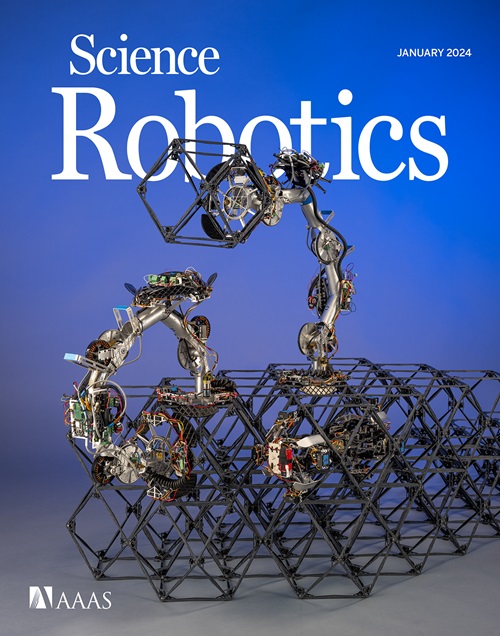Bird-inspired reflexive morphing enables rudderless flight
IF 26.1
1区 计算机科学
Q1 ROBOTICS
引用次数: 0
Abstract
Gliding birds lack a vertical tail, yet they fly stably rudderless in turbulence without needing discrete flaps to steer. In contrast, nearly all airplanes need vertical tails to damp Dutch roll oscillations and to control yaw. The few exceptions that lack a vertical tail either leverage differential drag-based yaw actuators or their fixed planforms are carefully tuned for passively stable Dutch roll and proverse yaw. Biologists hypothesize that birds stabilize and control gliding flight without rudders by using their wing and tail reflexes, but no rudderless airplane has a morphing wing or tail that can change shape like a bird. Our rudderless biohybrid robot, PigeonBot II, can damp its Dutch roll instability (caused by lacking a vertical tail) and control flight by morphing its biomimetic wing and tail reflexively like a bird. The bird-inspired adaptive reflexive controller was tuned in a wind tunnel to mitigate turbulent perturbations, which enabled PigeonBot II to fly autonomously in the atmosphere with pigeon-like poses. This work is a mechanistic confirmation of how birds accomplish rudderless flight via reflex functions, and it can inspire rudderless aircraft with reduced radar signature and increased efficacy.

受鸟类启发的反射变形实现了无舵飞行
滑翔翼鸟类没有垂直尾翼,但它们在乱流中却能稳定地无舵飞行,而不需要分散的襟翼来转向。相比之下,几乎所有飞机都需要垂直尾翼来抑制荷兰式滚转振荡并控制偏航。少数没有垂直尾翼的飞机要么利用了基于阻力的差动式偏航致动器,要么对其固定翼形进行了精心调整,以实现被动稳定的荷兰式滚转和逆向偏航。根据生物学家的假设,鸟类在没有方向舵的情况下,可以利用翅膀和尾部的反射来稳定和控制滑翔飞行,但没有一种无舵飞机拥有像鸟类一样可以改变形状的变形翅膀或尾部。我们的无舵生物混合机器人 PigeonBot II 可以抑制荷兰式的滚动不稳定性(由于缺乏垂直尾翼),并通过像鸟类一样反射性地变形其仿生翅膀和尾翼来控制飞行。受鸟类启发的自适应反射控制器在风洞中进行了调整,以减轻湍流扰动,从而使 PigeonBot II 能够在大气中以鸽子般的姿势自主飞行。这项工作从机理上证实了鸟类是如何通过反射功能实现无舵飞行的,它可以为无舵飞行器提供灵感,减少雷达信号并提高飞行效率。
本文章由计算机程序翻译,如有差异,请以英文原文为准。
求助全文
约1分钟内获得全文
求助全文
来源期刊

Science Robotics
Mathematics-Control and Optimization
CiteScore
30.60
自引率
2.80%
发文量
83
期刊介绍:
Science Robotics publishes original, peer-reviewed, science- or engineering-based research articles that advance the field of robotics. The journal also features editor-commissioned Reviews. An international team of academic editors holds Science Robotics articles to the same high-quality standard that is the hallmark of the Science family of journals.
Sub-topics include: actuators, advanced materials, artificial Intelligence, autonomous vehicles, bio-inspired design, exoskeletons, fabrication, field robotics, human-robot interaction, humanoids, industrial robotics, kinematics, machine learning, material science, medical technology, motion planning and control, micro- and nano-robotics, multi-robot control, sensors, service robotics, social and ethical issues, soft robotics, and space, planetary and undersea exploration.
 求助内容:
求助内容: 应助结果提醒方式:
应助结果提醒方式:


